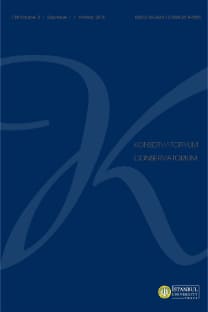Bir Oyunculuk Yöntemi Olarak Aktif Analiz
Konstantin Stanislavski, yaşamının son yıllarında, “Aktif Analiz” adında, daha önce ortaya koymuş olduğu yöntemlerden farklı, yepyeni bir çalışma yöntemi geliştirmiştir. Aktif analiz, Stanislavski’nin kitaplarında yer almayan bir oyunculuk yöntemidir. Zira Stanislavski, aktif analiz yöntemi ile ilgili bulgularını ve düşüncelerini yazma fırsatı bulamadan hayatını kaybetmiştir. Stanislavski’nin aktif analiz yöntemini geliştirme sürecine en yakından şahit olmuş kişi olan, öğrencisi ve asistanı Maria Knebel, 1950’li yıllarda, aktif analiz üzerine yazdığı makale ve kitaplarla, aktif analiz yönteminin Rusya’da tanınmasını sağlamıştır. Fakat, Knebel’in, aktif analiz üzerine yazdıkları, 2016 yılına dek İngilizce’ye çevrilmemiş; bu nedenle de, aktif analiz, 2016 yılına dek, Rusya dışında pek fazla bilinmeyen bir yöntem olarak kalmıştır. Bu çalışmada, aktif analiz yönteminin derinlemesine incelenmesi amaçlanmış; yapılan detaylı literatür çalışması ve çeşitli üniversitelerin oyunculuk bölümü öğrencileriyle yapılan pratik çalışmalar sonucunda elde edilen bulgular ışığında, aktif analizin bir oyunculuk yöntemi olarak işlevselliği değerlendirilmiş; aktif analiz yönteminin, oyuncunun yaratıcı potansiyelini açığa çıkaran, oyuncunun tüm yetilerini bütüncül bir şekilde kullanmasını ve oynayacağı karakteri tamamen organik bir biçimde yaratmasını sağlayan bir oyunculuk yöntemi olduğu sonucuna ulaşılmıştır.
Anahtar Kelimeler:
Aktif Analiz, Oyunculuk, Doğaçlama
Active Analysis as an Acting Method
Konstantin Stanislavski developed a brand-new working method in the last years of his life called active analysis that was different from the methods he had previously introduced. Active analysis is an acting method that does not appear in Stanislavski’s books, because he had passed away before finding the opportunity to write his findings and thoughts on the active analysis method. His student and assistant, Maria Knebel, was the one who had witnessed Stanislavski’s development of the active analysis method most closely, and she spread knowledge of this method in Russia with the articles and books she wrote on it in the 1950s. However, Knebel’s writings on active analysis would not be translated into English until 2016, thus leaving this method unknown outside of Russia until this time. This study aims to examine the active analysis technique in depth and evaluate its functionality as an acting method in light of the findings obtained from the detailed literature study as well as from practical studies with students from the acting departments of various universities. The study concludes the active analysis technique to reveal the creative potential of an actor, to allow actors to use all their abilities holistically and to create characters they can play completely organically.
Keywords:
Active Analysis, Acting, Improvisation,
___
- Carnicke, S. M. (2009). Stanislavsky in Focus: An Acting Master for the Twenty-first Century. New York: Routledge. google scholar
- Carnicke, S. M. (2010a). Stanislavsky’s System: Pathways for the Actor. A. Hodge (Ed.), Actor Training (pp. 1-25). New York: Routledge. google scholar
- Carnicke, S. M. (2010b). The Knebel Technique: Active Analysis in Practice. A. Hodge (Ed.), Actor Training (pp. 99 -116). New York: Routledge. google scholar
- Carnicke, S. M. (2014). The Effects of Russian and Soviet Censorship on the Practice of Stanislavsky’s System. R. A. White (Ed.), The Routledge Companion to Stanislavsky (pp. 697 -744). New York: Routledge. google scholar
- Carnicke, S. M. ve Rosen, E. (2014). A Singer Prepares: Stanislavsky and Opera. R. A. White (Ed.), The Routledge Companion to Stanislavsky (pp. 340 -390). New York: Routledge. google scholar
- French, S. D. ve Bennett, P. G. (2016). Experiencing Stanislavsky Today: Training and Rehearsal fort he Psychop-hysical Actor. New York: Routledge. google scholar
- Gillett, J. (2014). Acting Stanislavski: A Practical Guide to Stanislavski’s Approach and Legacy. London: Blooms-bury Publishing. google scholar
- Kamotskaia, K ve Stevenson, M. (2014). Decoding the System. R. A. White (Ed.), The Routledge Companion to Stanislavsky (pp. 745 - 793). New York: Routledge. google scholar
- Knebel, M. (2021a). On Active Analysis of the Play and the Role. A. Vassiliev (Ed.), Active Analysis (pp. 80-226). New York: Routledge. google scholar
- Knebel, M. (2021b). The Word in the Actor’s Creative Work. A. Vassiliev (Ed.), Active Analysis (pp. 227-527). New York: Routledge. google scholar
- Merlin, B. (2005). Beyond Stanislavsky: The Psycho-Physical Approach To Actor Training. London: Nick Hern Books Limited google scholar
- Merlin, B. (2007). The Complete Stanislavsky Toolkit. London: Nick Hern Books Limited google scholar
- Merlin, B. (2014). “Here, Today, Now”: Active Analysis for the Twenty-First-Century Actor. R. A. White (Ed.), The Routledge Companion to Stanislavsky (pp. 917 -965). New York: Routledge. google scholar
- Merlin, B. (2018). Acting: The Basics. New York: Routledge. google scholar
- O’Brien, N. (2018). Stanislavski in Practice: Exercises for Students. New York: Routledge. google scholar
- Stanislavski, K. (2013). Bir Rol Yaratmak (T. Göbekçin, Çev.). İstanbul: Alfa Yayınları. google scholar
- Thomas, J. (2016). A Director’s Guide to Stanislavsky’s Active Analysis. London: Bloomsbury Publishing. google scholar
- Toporkov, V. (2017). Stanislavski Provada (C. Yalaz, D. Dalyanoğlu, Ö. Eren, Çev.). İstanbul: Bgst Yayınları google scholar
- White, R.A. (2014). Stanislavsky: Past, Present, and Future. R. A. White (Ed.), The Routledge Companion to Stanis-lavsky (pp. 31-47). New York: Routledge. google scholar
- Whyman, R. (2013). Stanislavski: The Basics. New York: Routledge. google scholar
- ISSN: 2146-264X
- Yayın Aralığı: Yılda 2 Sayı
- Başlangıç: 2011
- Yayıncı: İstanbul Üniversitesi Devlet Konservatuvarı
Sayıdaki Diğer Makaleler
Piyanoda Hız Gerektiren Pasajların Farklı Ritim Kalıpları İle Çalışılmasının İncelenmesi
Plautus’un Amphitryon Oyununun Broadway ve Türkiye’deki Müzikal Uyarlamaları
Uygulamalı Tiyatro ile Yeni Bir Toplum Hayali
Bir Oyunculuk Yöntemi Olarak Aktif Analiz
Bir Postmodernizm Tartışması: György Ligeti’nin Le Grand Macabre Operası
Duygu KÜÇÜK ÖZBEK, Şebnem ÜNAL
Songs About The Đurumlije in Music Education
İkinci Dünya Savaşı’nın Sovyet Klasik Müziği’ne Etkileri
Saygun’s Perspective on Tradition and the Anatolian Melodies Used in the Opera Kerem
